Pet Safe Travel: 5 Flying Tips

by MANDI BROADBENT, CSR
Whether it’s Spring Break, Summer Vacation, or the Winter Holidays, we are always planning and dreaming of the next escape… especially once the travel restrictions begin to lift in a few weeks! Travel is good for us. It opens our minds and eyes to all the beauty in this wonderful world. It also allows us an opportunity to see how people live outside our own home towns. And who wouldn’t want to bring their four-legged best friend along?
According to the 2017 – 2018 National Pet Owners Survey, 68 percent of U.S. households (or 85 million families) own a pet (89 million dogs, in particular). This is an increase of 56 percent since 1988. Furthermore, 37 percent of pet owners (roughly 31 million families) travel with their pets every year, up from 19 percent a decade ago.
American Pet Products Association (APPA)
Wanting to include your furry friend on your adventures is a noble consideration. But realize, pet safe travel can get a little complicated.
With summer right around the corner and travel on everyone’s mind after a long and stressful few months, Lincolnshire Animal Hospital has 5 handy Pet Safe Travel Tips for making air travel with your four-legged friend a breeze.
Thinking about driving somewhere fun? Head over to our Road Trip Basics!
Thinking About Traveling By Plane?
Is your critter small enough to fit under your seat, or comfortably on the seat next to you? If not, you may want to avoid air travel with your pet. I know how that sounds, but crating a pet in the cargo hold of an airplane can be an incredibly stressful event for some pets. If it is unavoidable however, we’ve got some tips and tricks to try and make your travel a bit easier.

Always Book Direct
Try to avoid flights which remove you and your pet from the aircraft prior to your final destination. The more time your pet spends away from you, the more opportunities for an inexperienced baggage handler to mishandle, or even misplace, your furry friend. It also means more stress for your pet. Layovers and stops can also increase the chances that your pet could be left on the tarmac during less than ideal, or extreme weather.
Know Before You Go
The federal rules and regulations put in place by the United States Department of Agriculture (USDA) regarding pet safe travel are very specific, and ever changing. They also vary depending on which airline you are taking and your flight’s destination, both domestically and internationally. It is the responsibility of the passenger/flyer to know:
- Is the pet approved to travel? (Not all animals classify as pets)
- When is the deadline to submit your approved travel paperwork?
- Do you have a USDA approved pet-shipping crate?
- What vaccines are required to admit your pet to your destination (including any layover locations)?

You should check out the APHIS Pet Travel website a minimum of one month prior to travel to ensure you have plenty of time to take care of the legal requirements. Also, your airline or destination may have additional requirements aside from the USDA. It is a good idea to check with your airline to make sure there are no hiccups prior to your travel date. Remember, omitting information or skipping steps can potentially result in an uncomfortable, lengthy, and often expensive, quarantine for your pet! Once you have all your information, schedule your pet’s Travel Health Certificate with your veterinarian.
Don’t risk it – do your homework!
*Please note, if you feel your pet may benefit from a form of sedation due to travel anxiety, this should be discussed with your veterinarian as soon as possible. Ideally, if a new medication is to be prescribed, the doctor may request a trial of the drug to ensure that your pet tolerates it well prior to travel.
Crating and Identification are Key
The purchase of a USDA-approved pet shipping crate should be one of your first priorities.
The crate should be large enough for your pet to stand, sit and turn around in comfortably, and lines with some type of bedding – shredded paper towels – to absorb accidents. Take a small pouch of dried food outside the crate so airline personnel will be able to feed your pet in case he or she gets hungry during a layover. The night before you leave, freeze a small dish or tray of water for your pet. This way, it can’t spill during loading and will melt by the time he or she is thirty. Make sure the crate door is securely closed, but not locked, so that the airline personnel can open it in case of an emergency.
American Society for the Prevention of Cruelty to Animals (ASPCA) / Pet Safe Travel
Checking that your pet’s ID tags and microchip information is current and up-to-date is vitally important when traveling with your pet. If possible, we recommend forgoing the traditional collar and using a pet harness while traveling, as it is harder for your pet to escape a harness alone. Also, afixing a weatherproof sign on your pet’s kennel could be extremely important should a problem arise with your pet. This sign should include:
- “LIVE ANIMAL” in bold, large letters
- Name (Yours)
- Contact Cellphone Number
- Contact Number at your Destination (or Backup Phone Number)
- A Current Photo of Your Pet
Make sure you carry the same picture of your pet in your wallet to prove the pet is yours should anything happen.
Test It Out First

Before you spend your hard earned money on an airline ticket for your furry friend, make sure you know they can handle it first. After you choose an appropriate crate or pet carrier, you should spend time making sure that your pet is comfortable being in there for long periods of time. Consider even placing them in the kennel for a few road trips to see how they react to the crate outside of their normal home environment. Use familiar and comforting items such as blankets or toys to help create a calming space for your pet. Including items from home can bring a great level of stress relief however be mindful to not include anything your pet may try and eat, especially if we are a nervous traveler.
Talk Talk Talk It Up
It might seem odd, but tell every airline employee you encounter, both on the ground and in the air, that your pet is in traveling in the cargo hold. That way, if any additional attention or considerations are needed, the staff will be more more prepared. Also, maybe think about attaching a small baggie of your pet’s food or treats to the outside of the kennel. This allows airline employees to give your pet a treat if they get a moment.
And in the end, remember that your pet is your family. If you are concerned about the welfare of your pet, do not hesitate to speak up. It is your right to insist that airline personnel check the welfare of the animal whenever feasible.

Traveling with your pet can be a bonding experience for the both of you, so don’t be scared. By taking the proper precautions prior to travel, you are helping to ensure your four-legged friend’s vacation is as fun as yours.
GIFs provided by GIPHY.com

